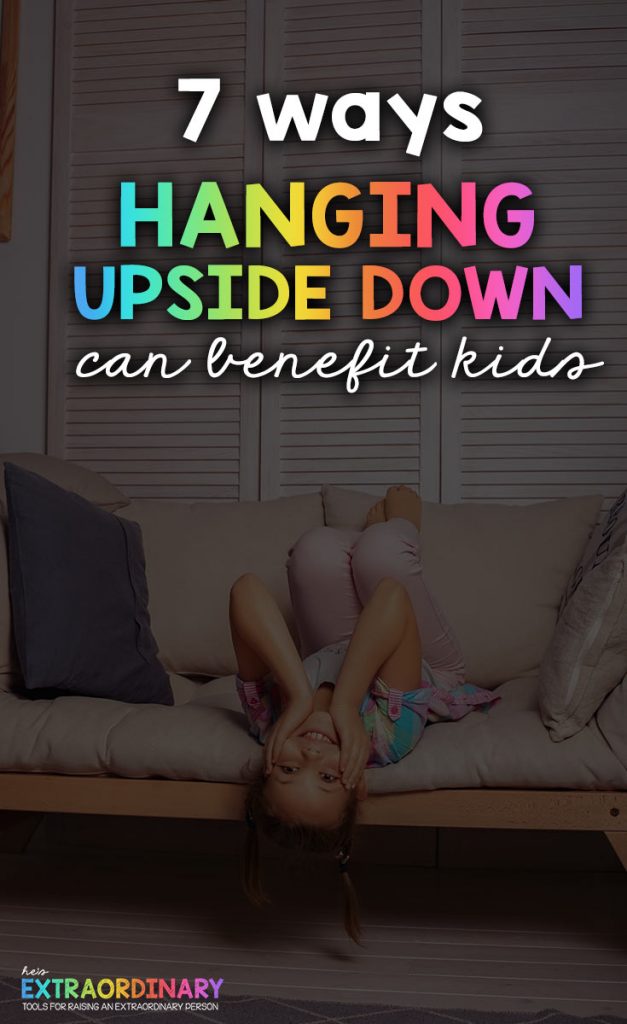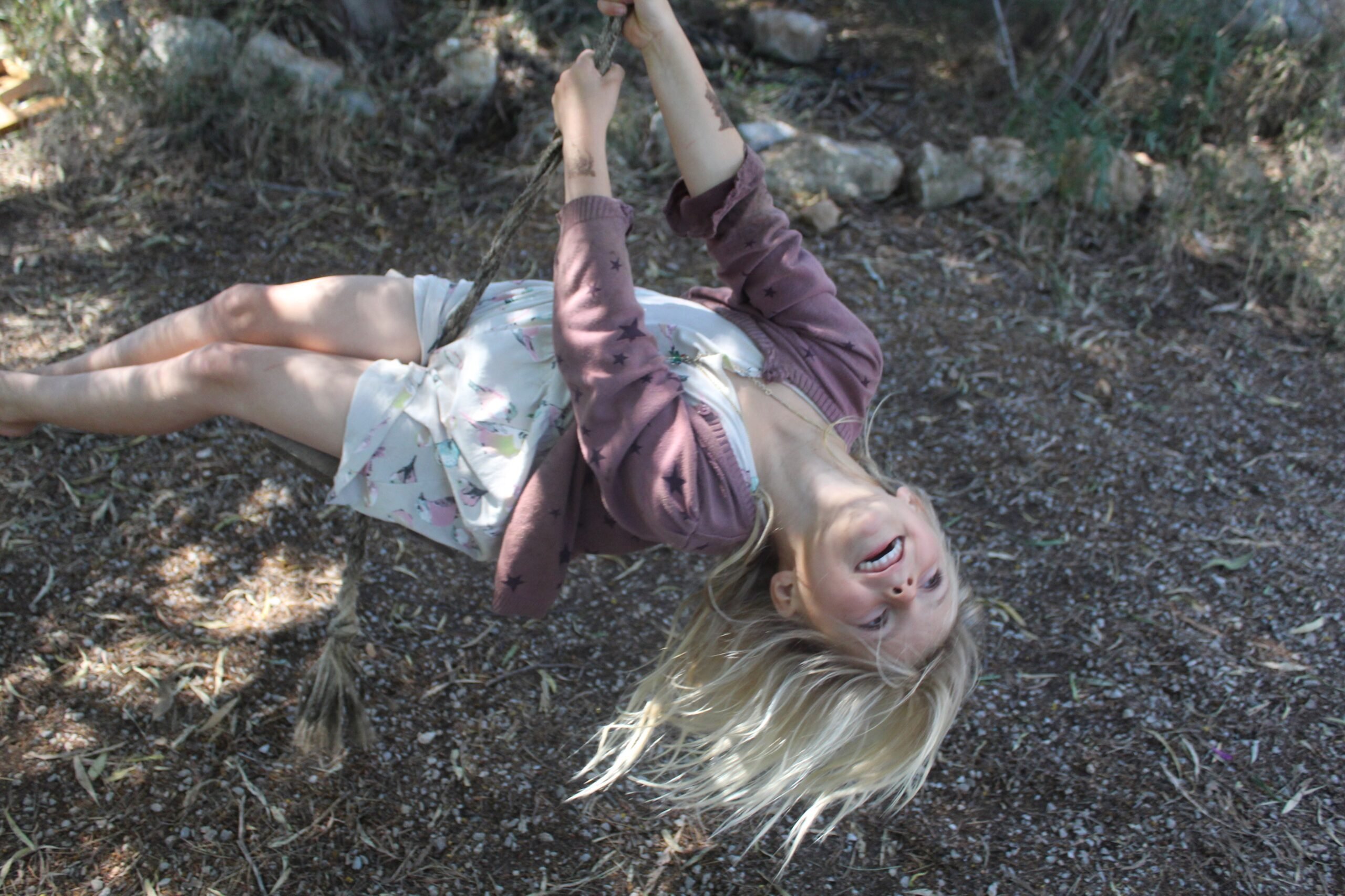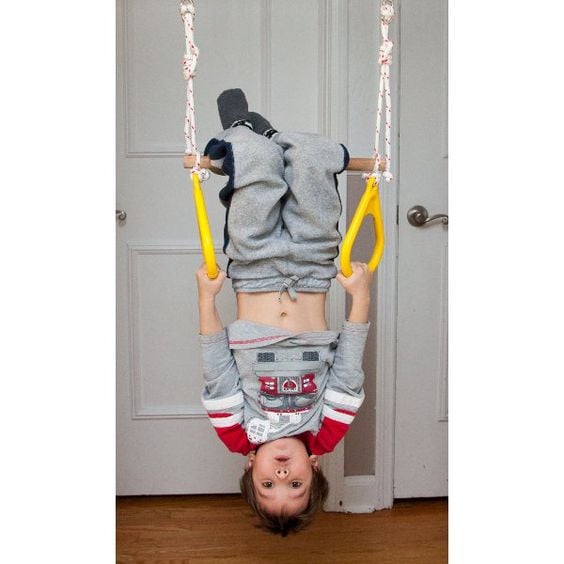The Benefits of Hanging Upside Down for Kids
What’s inside this article: A brief overview of the vestibular system, which is stimulated by hanging upside down, followed by the benefits of hanging upside down, and a list of child-friendly activities you can try.
Hanging upside down might seem like mere child’s play.
Yet, this simple action has more benefits than you may realize. In fact, it may play a vital role in self-regulation for sensory-seeking kiddos.
This article looks in more detail at the vestibular system, how hanging upside down sparks it, and then shares a roundup of fun and engaging child-friendly activities to explore.
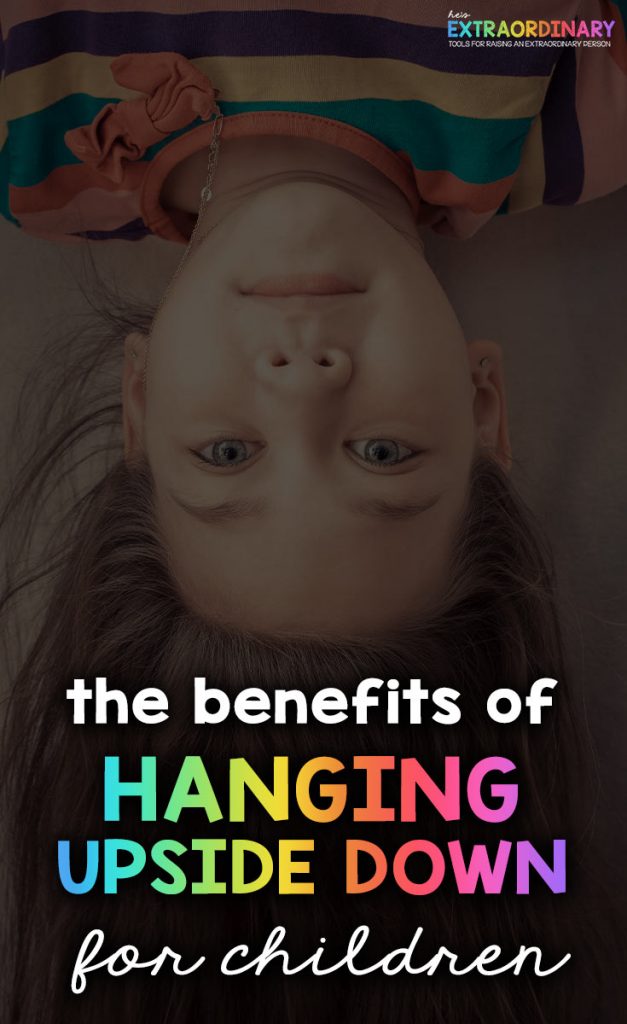
Understanding The Vestibular System
Before diving into the myriad benefits of hanging upside down, it’s essential to grasp the concept of the vestibular system.
What Exactly is the Vestibular System?
We all know the five basic senses: sight, taste, touch, smell, and hearing. But, we actually have three other, lesser known senses: proprioceptive, interoception, and vestibular.
Today, we’re talking about the vestibular system.
Often overlooked in comparison to our primary senses like sight and taste, the vestibular system is an integral sensory system contributing to:
- Balance
- Motor planning
- Motor skills
- Coordination
- Posture
- Body and Spatial Awareness
Originating in our inner ear, every twist, turn, or head tilt activates this system. For a detailed overview of its functionality, check out this article: here.
Recognizing the signs of vestibular-seeking behaviors in children is crucial.
Vestibular Seeking Behaviors: Spotting The Signs
Children with an under-responsive vestibular system will seek out movements that activate and meet their sensory needs.
Kids’ bodies intuitively know what they need, but they don’t always know the safest or most practical way of meeting those needs.
So, you might notice ‘sensory seeking behaviors’ that may seem disruptive or unsafe, but it’s just kids doing their best to have their sensory needs met.
This might look like:
- Spinning and rolling:
- Spinning in circles repeatedly (without getting dizzy)
- Twirling around or dancing constantly
- Rolling across the floor or down hills repeatedly
- Lying on the floor and twisting their body back and forth
- Spinning in a swivel chair or using furniture to rotate
- Jumping and bouncing:
- Jumping constantly—on beds, couches, trampolines, or the floor
- Bouncing in place while standing or sitting
- Repeatedly jumping off furniture or playground equipment
- Swinging and hanging:
- Wanting to swing for long periods of time
- Hanging upside down from furniture, monkey bars, or your arms
- Loves and seeks out hanging equipment like trapeze bars or hammock swings
- Climbing furniture or objects so they can invert themselves or change their head position
- Movement while seated:
- These are the kids who “never sit still”
- Rocking back and forth while sitting
- Tipping chairs or sitting on furniture improperly (e.g., backwards or sideways)
- Wiggling or fidgeting constantly when seated
- Benefits from using movement-based seating (wiggle cushions, therapy balls)
- Constant motion:
- Running everywhere instead of walking
- Crashing into walls or furniture deliberately
- Pacing back and forth or darting from room to room
- Leaping between furniture pieces like an obstacle course
- Head movements and inversion (hanging upside down)
- Head flopping off furniture (e.g., leaning backward over the couch)
- Hanging their head upside down when watching TV or reading
- Seeking handstands, cartwheels, or headstands
- Enjoying somersaults or log rolls excessively
- Risky or High-Intensity Play
- Seeking high-speed rides (e.g., merry-go-rounds, zip lines, spinning rides)
- Climbing to high places, even unsafely
- Pushing physical boundaries for the thrill or sensation
- Preferring fast bike rides or scooters over slower alternatives
- Toy & Object Use
- Using toy cars or skateboards to ride lying down
- Repeatedly swinging or spinning toys instead of using them for their defined function
- Creating games that involve a lot of spinning, bouncing, or rolling
If you’re seeing many of these behaviors, it doesn’t necessarily mean something is “wrong”…but it could be a signal that their nervous system is craving vestibular input to feel calm, focused, or alert.
Meeting those needs safely and intentionally (e.g., through swings, spinning seats, or movement breaks) helps regulate their system, reduces unsafe sensory seeking, and improves regulation.
When children excessively seek vestibular input, if they aren’t supported, it can significantly interfere with their daily functioning.
For example, it’s nearly impossible for a child to sit still and concentrate at school when their vestibular sensory needs aren’t met
Benefits of Hanging Upside Down
You might’ve noticed kids hanging upside down, engrossed in conversations, or just observing the world from a unique perspective.
Well, their innate instincts are pointing them to numerous advantages.
There are many benefits to hanging upside down:
- Provides strong and distinctive vestibular input, which supports balance, posture, and spatial orientation.
- Calms and regulates the nervous system
- Offers deep pressure to the joints and muscles if they’re hanging from their arms or legs. This is proprioceptive input.
- Offers both calming and alerting effects, so it can reduce restlessness and anxiety in some kids and also help with focus and attention.
- Helps avoid sensory overload and consequent meltdowns
- Encourages the brain to interpret input from different angles, which can help improve visual-spatial processing and flexibility in sensory-motor responses.
Plus… these benefits can last for hours! Meaning periodic short bursts of upside-down fun is a potent tool for sensory stimulation.
Important Notes:
Although there can be risks involved if hanging upside down for extended periods of time, generally speaking, kids can hang upside down as often as they like, as long as you are following their cues.
Just like with anything else, hanging upside down isn’t for everybody. Some kids have sensory sensitivities or a low threshold for motion. If that’s the case, they could get dysregulated from being upside down.
So, pay attention to how your child responds during and after an activity that involves hanging upside down. If at any time they indicate that they don’t want to be upside down or complain of feeling dizzy, stop immediately.
Don’t force a child who doesn’t want to be upside down to invert their head.
Activities That Involve Hanging Upside Down
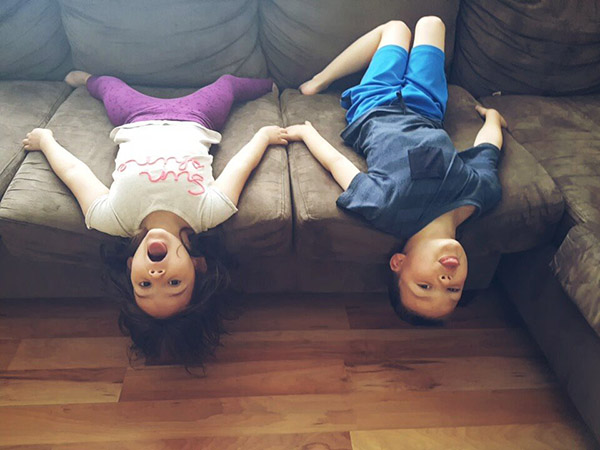
There are a lot of different ways you can fit inverting the head into regular play with your kids.
Here are some ideas to get you started:
- Hanging upside down from the couch
- Children’s Yoga – various yoga moves (like downward dog) include inverting the head
- Hanging from the monkey bars at the playground
- For younger children, you can set them on your lap, facing you, and hold their hands while letting them drop back upside down over your knees, then pull them back up.
- Lean backward over a large exercise ball.
- Gymnastics and tumbling: cartwheels, forward and backward rolls, bridge walking, etc., all involve inverting the head.
- Get an indoor trapeze bar – so your kiddo can hang upside down in the house (mounts onto door frame) as much as they like! (Seriously, this thing is AWESOME and will help save your sanity if you feel as crazy as I do when you watch your child leap and roll all over the sofa.)
- Inversion Swings or Hammocks: Install a safe inversion swing or hammock at home or in the garden where kids can safely swing and hang upside down under supervision.
- Aerial skills or circus arts: there are classes where kids can learn beginner’s trapeze or how to perform various poses and sequences while suspended from silk fabrics, including upside-down positions.
- Doing headstands against a wall (with help if needed) – this also helps build core strength and provides tons of proprioceptive input, too.
- Swinging on your stomach on a swing at the playground.
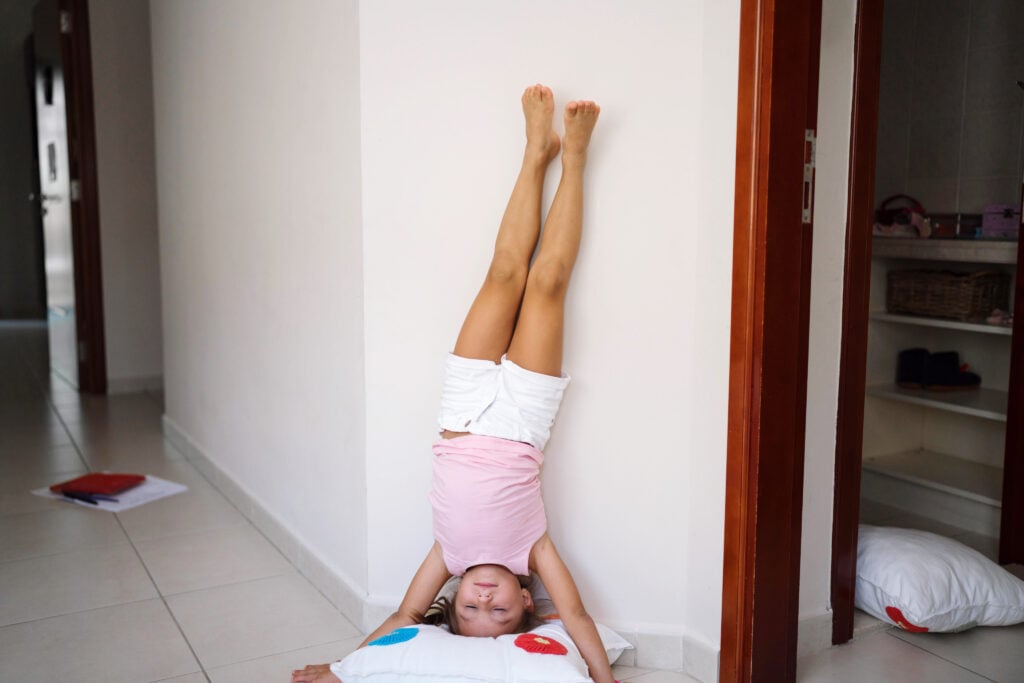
Other Vestibular Input Activities
Hanging upside down is not the only thing that stimulates the vestibular system, although it is one of the most effective and unique experiences.
Other activities and games you can play include:
- Freeze dance (one of our favorites) – everybody dances really fast to the music, and then when the song pauses, you freeze! No matter what silly position you were in.
- This 7-minute HIIT workout
- Riding a bike
- Playing on the swings and slides at the playground
- Swimming (also a great proprioceptive activity)
- Rhythmic bouncing or rocking on your lap
- Jumping on a trampoline
- Pulling your child around the floor on a blanket
- Crashpad
- Playing ring-around-the-Rosie
- This morning workout for kids
- Basically, anything that involves moving your body, especially your head.
If you’d like even more ideas for sensory activities, read: 52 Vestibular Input Activities for Sensory Seekers.
What About Spinning?
Rolling down hills or spinning in circles are favorites among kids.
Why?
They’re tapping into the vestibular system.
But remember:
- Slow, methodical spinning can soothe.
- Rapid, abrupt spins might overstimulate.
Always keep an eye out and follow your child’s cues. Some kids can spin forever, and they’ll never feel dizzy; others can barely play a game of ring-around-the-rosie (I’m others).
If your child doesn’t enjoy or react well to an activity like spinning or hanging upside down, don’t force them to participate.
Everybody processes sensory input differently.
Be Proactive
One of the best ways to minimize sensory-seeking behavior and meltdowns is to be proactive. Regular sensory breaks and hanging upside down can improve your child’s focus and prevent excessive hyperactivity throughout the day, at times when there are expectations for them to be calm and focused.
Check out this 7-minute morning activity for kids that can help improve self-regulation.
Plus, discover some more excellent strategies for proactively preventing meltdowns here.
